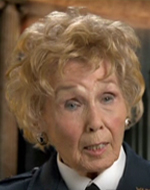
Deanie Parrish
Deanie Parrish served in the Women Airforce Service Pilots (WASP) during World War II. She logged hundreds of hours of flight time in numerous aircraft and made it her mission to convince Congress to award the long-neglected WASP the Congressional Gold Medal.
QUESTION: Why did you join?
DEANIE: Well, that's very easy to answer. I joined because I had learned to fly about a year
earlier. When I was growing up in Florida we had no female pilots in my little town. But just
before World War II began a primary school for cadets moved into the town and here were all
these young men who were my peers. I was working in the bank in the afternoons and on
Saturdays as a teller and these good-looking instructors would come in to [LAUGHS] cash their
checks. One day I wondered why they didn't have any girls learning to fly, so I asked one of the
instructors why just because I'm a girl can't I learn to fly? And he didn't have an answer. So I
decided to find out. So I found a married instructor who owned his own private airplane and
asked him if he would teach me to fly. And he did. This was before the WASP were ever
thought of. So I learned to fly from this private instructor. While I was learning to fly, on my
first solo flight I had asked my instructor before do you think I will ever make a good pilot? He
said, Deanie, I can't tell you, but someday something will happen and you will know whether or
not you will be a good pilot. On my first solo flight in a Piper Cub we had made a couple of
landings and he said I think you're ready to solo. So we stopped, he got out of the airplane, and
in a Piper Cub the instructor always sits in the front seat and the student in the back seat. He
knotted up his seat belt so it wouldn't go down in the rudders and he got out. He said, okay take
it around. When I took off in that Piper Cub in the back seat and got up to an altitude where you
always level off before you climb any higher because you're almost out of power, I got to that
point I had my hand on the throttle, on the stick, and as I started to push forward on that stick to
level off, it came off in my hand. My first thought was he did this on purpose to see if I would
be a good pilot. Then I realized I was about to crash so I grabbed my seat belt off, held the
throttle wide open and I reached over that front seat and with the tips of my fingers I could reach
that front stick and I started easing it forward. When I knew that I had sufficient speed that I
wouldn't crash, I climbed over into the front seat. I finally got the seat belt off and on. He said
as he watched me from the ground he swore if I ever got down alive, I would never fly in an
airplane again. But as I got the seat belt on and started my pattern around the field to come in
and land, all of a sudden I noticed there's a big red sign up there that says do not solo from front
seat. I thought, well, it's too late [LAUGHS]. So I came in and made a fairly decent landing. As
I taxied over toward him he started walking away. I finally just stopped and I thought, he'll
never let me fly again. He turned around and came back over towards the airplane with his head
down. When he walked up he looked in the back seat and looked up at me and he said what in
the hell are you doing in the front seat? And I just pointed to that stick. When he saw that stick
he said something to me that I never forgot. He said now you know you have the right stuff to be
a pilot. And that was before John Glenn had the right stuff.


